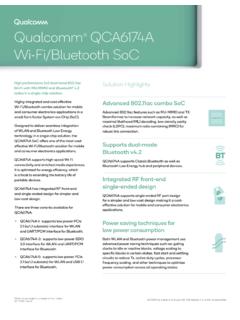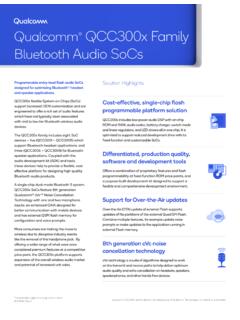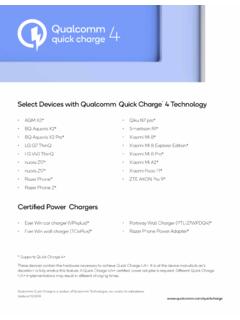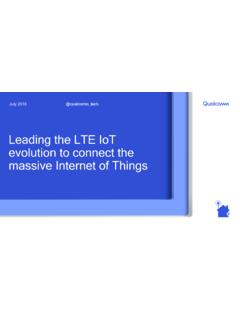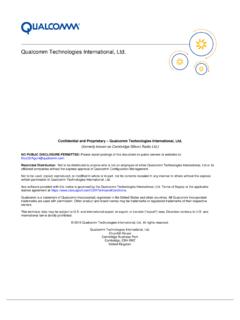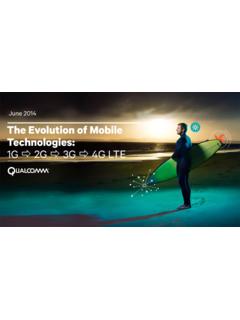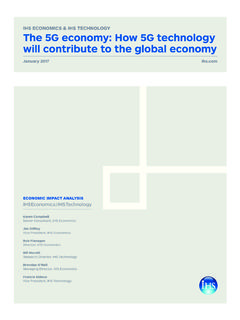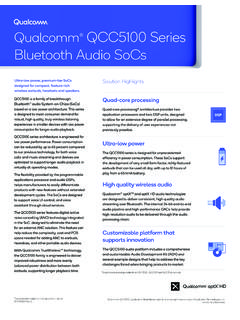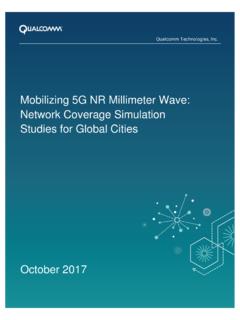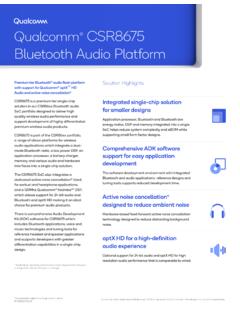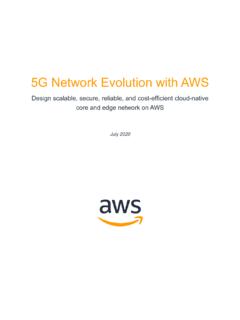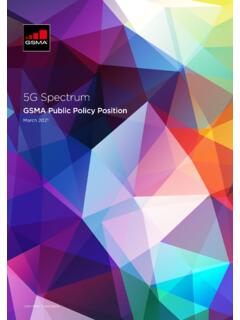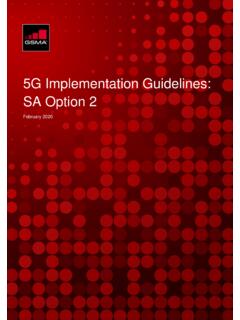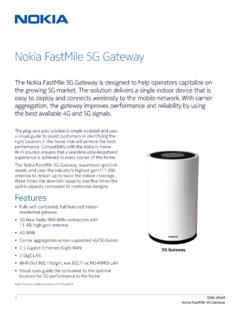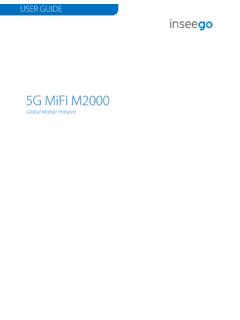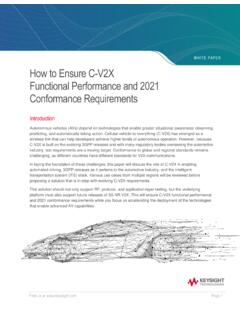Transcription of Designing 5G NR - Qualcomm
1 Designing 5G NRThe 3 GPP Release 15 global standard for a unified, more capable 5G air interface@qualcomm_techSeptember 201822 Diverse services Diverse deployments Mid-bands1 GHz to 6 GHz High-bandsAbove 24 GHz (mmWave)Low-bandsBelow 1 GHzMassive Internetof ThingsDiverse spectrum NRDesigning a unified, more capable 5G air interfaceExisting, emerging, and unforeseen services a platform for future innovationMission-criticalservicesEnhanc ed mobilebroadband5 GNRL icensed/shared/unlicensed3 Driving the 5G roadmap and ecosystem expansion201820172020201920222021 Rel-17+ evolutionRel-16 Rel-15 Rel-16 Commercial launchesRel -15 Commercial launchesNRField trialsIoDTsStandalone (SA)Continue to evolve LTE in parallel as essential part of the 5G PlatformNon-Standalone (NSA)We are hereeMBBdeploymentsand establish foundation forfuture 5G innovationsNew 5G NR technologies to evolve and expand the 5G ecosystem445G NR pioneering advanced 5G NR technologies To meet an extreme variation of 5G NR requirementsBased on ITU vision for IMT-2020 compared to IMT-advanced; URLLC: Ultra Reliable Low Latency Communications.
2 IAB: Integrated Access & Backhaul10xConnection density3xSpectrumefficiency10xDecrease inend-to-end latency10xExperienced throughput100xTrafficcapacity100xNetwork efficiency LiveEnhanced mobile broadbandMission-critical servicesMassive Internet of ThingsCellular Vehicle-to-Everything (C-V2X)Ultra Reliable Low Latency Comms(URLLC)Drone communicationsPrivate NetworksDeeper coverageGrant-free ULEfficient signalingNarrow bandwidthEnhanced power save modes Massive MIMOS calable OFDMM obile mmWave Flexible slot-based frameworkSpectrum sharingAdvanced channel codingDual Connectivity55 The R&D engine fueling the 5G industry3 GPP standards and technology leadership Our system-level inventionsare foundational to 5G NR standardEarly system-levelR&D investmentsDesigning/testing 5G for many yearswith best-in-class prototype systemsGlobal network experience and ecosystem collaborationsIndustry-leading demos, simulations, testing and trials on path to commercialization Building on our LTE technology leadershipNRVodafone Group65G NR design and technologies3 GPP Release-1577 Address diverse services, spectrum.
3 DeploymentsScalable OFDM-based air interfaceScalable OFDM numerology Flexible slot-based frameworkSelf-containedslot structureAdvanced channel codingMassive MIMOM obile mmWaveMulti-Edge LDPC and CRC-Aided PolarReciprocity-basedMU-MIMOLow latency, URLLC, forward compatibility Supportlarge data blocks, reliable control channelLarge# of antennas to increase coverage/capacity For extreme capacity and throughputBeamformingand beam-trackingOur technology inventions drove Rel-15 specificationsEarly R&D investments | Best-in-class prototypes | Fundamental contributions to 3 GPP8 November 2015 Qualcomm Technologies 5G Analyst Day5G NR standard aligned with our early 5G designA testament to the impact of our early 5G R&D and fundamental contributions to 3 GPP99 Scalable OFDM-based 5G NR air interface3 GPP Rel-15 specifications aligned with Qualcomm Research whitepaper published Nov 2015 [link] Qualcomm Research is a division of Qualcomm Technologies, Such as Weighted Overlap Add (WOLA) utilized in LTE systems today.
4 2. DFT-Spread (DFT-S) OFDM. 3. Such as non-orthogonal Resource Spread Multiple Access (RSMA) 2nscaling of sub-carrier spacing to efficiently support wider bandwidthsWindowing1can effectively minimize in-band and out-of-band emissionsSingle-carrier2 OFDM utilized for efficient uplink transmissionsCan co-exist with optimized waveforms and multiple access for IoT UL3 TimeFrequencyFrequency localizationLower power consumptionAsynchronous multiple accessScalable numerology 1010 Scalable 5G NR OFDM numerology examples Efficiently address 5G diverse spectrum, deployments and services Scaling reduces FFT processing complexity for wider bandwidths with reusable hardwareOutdoor macro , FDD 700 MHzIndoor , unlicensed 6 , TDD 28 GHzOutdoor macro and small , TDD 3-5 GHzSub-Carrier spacing, kHzCarrier bandwidth, 1,5,10 and 20 MHzCarrier bandwidth, 160 MHzCarrier bandwidth, 400 MHzCarrier bandwidth.
5 100 MHzSub-Carrier spacing, kHzSub-Carrier spacing, kHzSub-Carrier spacing, kHz2nscaling of Sub-Carrier Spacing (SCS)1111 Designed for diverse spectrum bands/typesGlobal snapshot of 5G spectrum bands allocated or targetedLicensedUnlicensed/sharedExistin g bandNew 5G band600 MHz (2x35 MHz) (2x30 MHz) 5 GHz 600 MHz (2x35 MHz) (LTE B41) GHz700 MHz (2x30 MHz)700 MHz (2x30 MHz)700 MHz (2x30 MHz)700 MHz (2x30 MHz)5 GHz4 GHz3 GHz< slot-based 5G NR frameworkEfficiently multiplex envisioned and future 5G services on the same frequencyURLLCeMBB transmissionDL CtrlUL CtrleMBBD2 DMulticastBlank subcarriersNominal traffic puncturingTo enable URLCC transmissionsto occur at any time using mini-slotsForward compatibilityTransmissions well-confined in time/frequency to simplify adding new features in futureScalable slot durationEfficient multiplexing of diverse latency and QoSrequirementsSelf-contained slot structureAbility to independently decode slots and avoid static timing relationships across slots1313 Scalable 5G NR slot duration for diverse latency/QoS1.
6 As low as two symbols per mini-slot; 2. Symbols across numerologies align at symbol boundaries and transmissions span an integer # of OFDM symbols 14 OFDM symbols per slot withmini-slot (2, 4, or 7 symbols) for shorter transmissions1 Supports slot aggregation for data-heavy transmissionsEfficient multiplexing of long and short transmissions2012111213345678910 SlotMini-Slot500 sSlot250 sSlot125 sSubframe1ms subframe aligned with LTECP-OFDM Symbol15 kHz SCS30 kHz SCS60 kHz SCS120 kHz SCS14 Flexible 5G NR slot structures ExamplesDL reference signals (DL DMRS) & UL Reference + Sounding (UL DSMR, SRS) not showed for simplicityBlank slotDesigned in a way not to limit future feature introductionsSlot-based scheduling/control intervalTDD Self-ContainedOpportunity for UL/DL scheduling, data and ACK/SRS in the same slotDL DataDL CtrlUL CtrlDLGuardDL CtrlUL DataUL CtrlGuardULData-centricMore relaxed TDD timing configurations + FDD operationDL CtrlDL DataDLUL DataUL CtrlULMini-slotOptimized for shorter data transmissions, , 2-symbol , 4-symbol mini-slotUL15UL DataGuardBenefits of the 5G NR TDD self-contained slotMuch faster, more flexible TDD switching and turn-around than 4G LTE1.
7 Sounding Reference SignalDL DataDL CtrlULCtrlGuardDL CtrlTDD ULTDD DLMore adaptive UL/DLFaster TDD switching allows for more flexible capacity allocationSRSACKE fficient massive MIMOO ptimized TDD channel reciprocity with opportunity for SRS1every slotLow latencyFaster TDD turn-around, with opportunity for UL/DL scheduling, data and ACK in the same slotFlexibility for additional , channel reservation header for unlicensed/shared spectrum16165G NR TDD self-contained slot structure in action Three examples showcasing faster TDD switching for low latencyDL reference signals (DL DMRS) & UL Reference + Sounding (UL DSMR, SRS) not showed for simplicitySlot 0: 500 sSlot 1: 500 sSlot 2: 500 sSlot 3: 500 s123 Slot 0: 125 sSlot 1: 125 sSlot 2: 125 sSlot 3: 125 sSlot 4: 125 sSlot 5: 125 sSlot 6: 125 sSlot 7: 125 s1. Indoor (sub-6 or mmWave)2.
8 Outdoor (sub-6 or mmWave)3. Outdoor mmWave DL CtrlDL DataUL CtrlUL Data175G NR flexible FDD slot structureDelivering low latency, extended coverage, and forward compatibility FDD baseline for continuous transmission and extended coverageUL DataUL CtrlULCtrlDL CtrlDL DataFDD full DL SlotFDD full UL Slot FDD partial slot for faster DL/UL turn-around and efficient half-duplex FDD implementation FDD partial DL SlotFDD partial UL Slot DL CtrlDL DataUL DataUL rate (R)LDPCP olarTurbo0 Advanced ME-LDPC1channel coding is more efficient than LTE Turbo code at higher data ratesSelected as 5G NR eMBBdata channel as part of 3 GPP Release-15 1. Multi-Edge Low-Density Parity-CheckHigh efficiencySignificant gains over LTE Turbo particularly for large block sizes suitable for MBBLow complexityEasily parallelizable decoder scales to achieve high throughput at low complexityLow latencyEfficient encoding/decoding enables shorter transmission time at high throughput Normalized throughput (for given clock rate)519 Performance gains of CRC-Aided Polar channel coding led to its adoption across many 5G NR control use cases1.
9 Parity-Check Polar channel codingLink-levelgains of 5G NR CA-Polar design Versus PC-Polar1(lower is better)Rate = = = SNR (dB) for BLER = payload size (bits)CA-PolarPC-Polar5G NR CRC-Aided (CA-Polar) designEfficient construction based on single Cyclic Redundancy Check (CRC) for joint detection and decodingU-domain bit mappingPolar encoder (Arikankernel)Rate matching & channel bit interleavingControl payloadTo modulation mapperSingle CRC Concatenation as Outer Code20205G NR optimized design for massive MIMOKey enabler for using higher spectrum bands, 4 GHz, with existing LTE sites C1. Sounding Reference Signal. 2. Channel State Information Reference Signal; 3. High-Power User Equipment (HPUE) Txpower gainsOptimized design for TDD reciprocity proceduresutilizing UL SRS1 Enhanced CSI-RS2design and reporting mechanism New features, such as distributed MIMOA dvanced, high-spatial resolution codebook supportingup to 256 antennasEnabled through an advanced 5G NR end-to-end Massive MIMO design (network and device)Exploit 3D beamforming with up to 256 antenna elements Accurate and timely channel knowledge essential to realizing full benefitsUL SRS CSI-RS5G NR co-located with existing LTE macro sitesMitigate UL coverage with 5G NR massive MIMO + HPUE321 SRS + PUCCHStep 1:UL SRS1 Precoding decision DL PrecodedCSI-RS2 Step 2:CSI-RS UE CQI3feedbackStep 3.
10 Precoding + CQI Final scheduling TDD slotDLAsynchronous CSI-RSSRS + PUCCHDLMIMO rate prediction latency reduced from >10 msin LTE to 1 msin 5G NR 5G NR optimized design for TDD reciprocity procedures5G NR slot structure and enhanced Ref Signals enable fast/accurate feedback*Sub-6 GHz, macro cell numerology, 30 kHz tone spacing; Channel sounding opportunity increases from <= 200 Hz with LTE to 2 kHz with 5G NR. 1. Sounding Reference Signal. 2. Channel State Information Reference Signal. 3. Channel Quality IndicatorDL CTRLSRS + PUCCH22 Faster, more uniform data rates throughout cell5G NR massive MIMO increases coverage & capacityAssumptions: carrier frequency 4 GHz; 200m ISD, 200 MHz total bandwidth; base station: 256 antenna elements (x-pol), 48dBm Tx power; UE: 4 Tx/Rx antenna elements, 23dBm max. Tx power; full buffer traffic model, 80% indoor and 20% outdoor MIMO5G NR Massive MIMO5G NR Massive MIMO4x4 MIMO52 Mbps195 Mbps27 Mbps79 MbpsMedian Burst RateCell-edge Burst Rate2323 The large bandwidth opportunity for mmWaveThe new frontier of mobile broadband5G NR sub-6 GHz( GHz)NR6 GHz24 GHz100 GHzLower latencyOpens up new opportunitiesMuch more capacityWith dense spatial reuseMulti-Gbpsdata ratesWith large bandwidths (100s of MHz)Unified design across diverse spectrum bands/types5G NR mmWave( GHz, GHz)24 Overcoming numerous challenges to mobilize mmWaveCoverageAnalog beamforming with narrow beamwidthto overcome significant path loss in bands above 24 GHzRobustnessAdaptive beam steering and switching to overcome blockage from hand, head, body and foliageDevice size/powerDifferent antenna configurations (face/edge)
